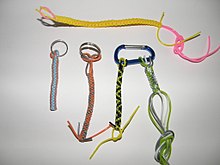Scoubidou
Scoubidou , also called Scooby-Doo in English, means knotted objects, in German Hexentreppchen .
history
Scoubidous are used in West Africa to decorate ceramics, among other things, here they are also known as roulettes or, more precisely, "braided strip roulette" or "plaited cord roulette". They have been in use since at least the 1st millennium BC. The first evidence in the Nile Valley comes from the post- Meroite period.
Europe
Ribbons, especially key fobs , made of colored plastic ribbons (actually thin-walled PVC tubes) are also called this. The European Scoubidou handicrafts probably spread from France via the Saarland to Germany. As early as the 1980s, scoubidous were knotted from the insulation of electrical wires or from wool threads. The name is said to come from a hit of the same name by the chansonnier Sacha Distel (1933-2004), whose fans wore small wickerwork made of guitar strings.
Health risks
The Scoubidou-knotting is 2004 in the criticism advised because the used plastic bands plasticizers ( phthalates ) contain hazardous to your health and the risk of cancer increases, children being particularly vulnerable.
literature
- Inge Walz: Knot fun with Scoubidou. All the knots, tips and tricks . Frech Verlag, 2004, ISBN 3-7724-5218-3 .
- Sabine Koch: Animals and Figures with Scoubidou. Funny knotting ideas . Frech Verlag, 2004, ISBN 3-7724-3314-6 .
- Jean-Claude Painsecq, Jean-Pierre Hurtrer, Sandrine Deon: Scoubidou total. 222 knot hits for cool kids . OZ Verlag, 2004, ISBN 3-89858-722-3 .
Web links
Individual evidence
- ^ Anne Mayor: Braided strip roulette . In: A. Haour, K. Manning, N. Arazi, Oliver Gosselain, Ndèye Sokhna Guèye, D. Keita, Alexandre Livingstone Smith, Kevin MacDonald, Anne Mayor, S. McIntosh, R. Vernet (Eds.): African Pottery Roulettes Past and Present, echniques, Identification and Distribution . Oxbow Books, Oxford 2010, JSTOR j.ctt1cfr9fr.14
- ↑ Alexandre Livingstone Smith, Olivier Gosselain, Anne Mayor, Ndèye Sokhna Guèye: Modern roulettes in sub-Saharan Africa . In: A. Haour, Kate Manning, N. Arazi, Olivier Gosselain, Ndèye Sokhna Guèye, D. Keita, Alexandre Livingstone Smith, Kevin MacDonald, Anne Mayor, S. McIntosh, R. Vernet (Eds.): African Pottery Roulettes Past and Present, Techniques, Identification and Distribution . Oxbow Books, Oxford 2010, JSTOR j.ctt1cfr9fr. 6
- ^ Alexandre Livingstone Smith: Histoire du décor a la roulette en Afrique subsaharienne . In: Journal of African Archeology , 5/2, 2007, pp. 189-216, JSTOR 43135430
- ^ Robert Soper: Roulette Decoration on African Pottery: Technical Considerations, Dating and Distributions . In: African Archaeological Review , 3, 1985, 29-51, JSTOR 25130449

